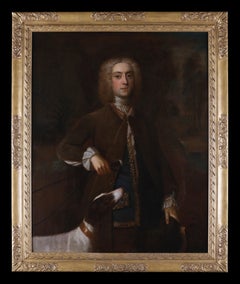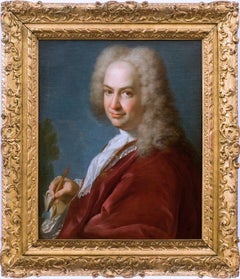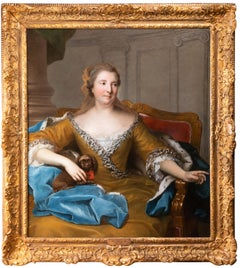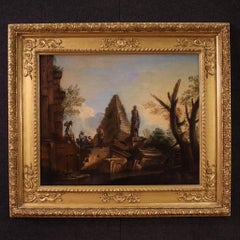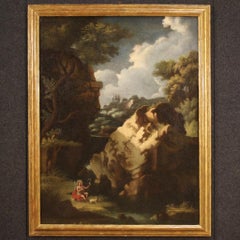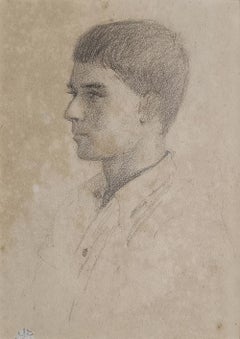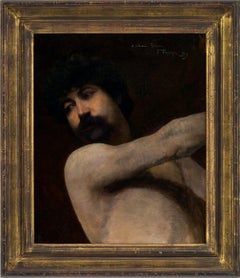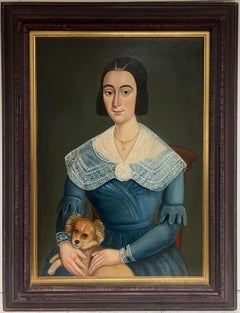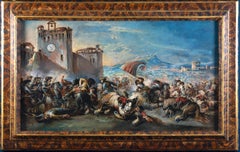1730s Figurative Paintings
to
1
1
1
4
Overall Width
to
Overall Height
to
958
2,422
13,266
30,532
286
287
565
782
573
764
921
979
1,027
1,007
461
2
1
5
1
6
3
2
2
2
1
1
1
1
5
5
4
4
1
1
5
1
5
Period: 1730s
Portrait of a Gentleman with his Dog - Possibly Abraham Tucker. Oil on Canvas
By Enoch Seeman
Located in St. Albans, GB
Enoch Seeman - 1894 - 1744
An excellent example of Seeman's work. It is typically unsigned as was the case of many portraits of that time. A three quarter length portrait showing a r...
Category
Old Masters 1730s Figurative Paintings
Materials
Oil
Presumed artist self-portrait
Located in BELEYMAS, FR
Louis-Gabriel BLANCHET
(Versailles, 1701 – Rome, 1772)
Presumed self-portrait of the artist
Oil on canvas
H. 73 cm; W. 60 cm
Circa 1730
Originally presented in a Restoration period frame with a "Mignard" cartouche, this beautiful painting initially appeared to us as a work from northern Italy. However, it exuded a rather French form of refinement, suggesting that its artist may have assimilated a dual influence from both sides of the Alps.
We thank our colleague and friend Philippe Mendès for spontaneously and judiciously "bringing out" the name of Louis-Gabriel Blanchet, a Romanized French portraitist, whose spirit and stylistic characteristics we clearly recognize here.
Blanchet's "French" years, before his final departure for Rome in 1728, following his winning of the second Grand Prix for painting after Subleyras in 1727, are extremely poorly documented. His father, Gabriel, was valet to Blouin, himself Louis XIV's first valet at the time. According to Thierry Lefrançois, Blanchet was one of the few students of Nicolas Bertin (1667-1736), whose studio he is said to have joined in the early 1720s. At a baptism on March 24, 1724, where he was godfather, he is mentioned as a painter in the picture store of the Duke of Antin, the director of buildings between 1708 and 1736. At this time, he was probably already married to Jeanne Quément, with whom he had a daughter also named Jeanne, who would marry Nicolas Aviet, the son of a valet in the queen's wardrobe, in Versailles in 1738.
When Blanchet arrived in Rome in October 1728, he was accompanied by Subleyras, Trémolières, and Slodtz. He enjoyed the goodwill of Vleughels, the director of the Académie de France, which had been based at the Palazzo Mancini since 1725, even though the latter was not always kind to our resident. From 1732, he was under the protection of the Duke of Saint-Aignan when he took up his post as ambassador to Rome. Along with Slodtz and Subleyras, they formed a trio of friends, joined by Joseph Vernet shortly after his arrival in Rome in 1734. Slodtz and Blanchet, on the occasion of Subleyras's marriage in 1739, were there to attest that their friend was not bound by any marital commitment, and Blanchet was a witness at Vernet's wedding in 1745.
It is most likely from these early years in Rome that our portrait of the artist dates, the expression and turn of his face irresistibly reminiscent of a self-portrait. The still relatively youthful features may correspond to Blanchet's thirty-something years, and the fluffy wig was still fashionable at this time.
The painting fits well with the depiction of a young painter wanting to display both the beginnings of success and a certain simplicity or restraint. A slight smile expresses a form of assurance in this man with a gentle, sincere gaze and a face radiating a keen sense of wit. We find here the air of intimacy present in almost all of Blanchet's portraits, even those from the 1750s and 1760s, as well as an almost complicity with the viewer. The spirit of the painting is quite close to that of the presumed portrait of Bouchardon (painted around 1730) and the portrait of Pannini, painted in 1736, but it possesses a more natural quality, notably thanks to the absence of decorum. Our work exhibits the characteristics of Blanchet's paintings: elegance, luminosity (especially in the whites), vibrant and refined colors (here, the harmony of the garnet of the garment and the slate blue of the background, whose uniformity is tempered by a very sketched landscape and a grove of greenery), light complexions, rather rosy cheekbones, often full lips, and rather tight framing.
According to the Academy's rules, Blanchet's stay should have ended in the spring of 1732, but, for reasons unknown, he remained in the Eternal City until his death, as did his friend Subleyras, with whom he shared accommodation until the late 1730s. The latter regularly called upon him to collaborate on his paintings, such as The Meal at Simon's. Through Saint-Aignan's intervention, Blanchet was employed in the late 1730s by the Stuart princely family, then exiled in Italy. He notably produced copies (now lost) after Liotard of the portraits of Charles Edward and Henry Benedict, the sons of James III Stuart. The latter also commissioned three other portraits (now in the National Portrait Gallery in London), whose more formal character contrasts with the intimate spirit of Blanchet's portraits. Blanchet frequented English painters, such as the landscape painter Richard Wilson, and studied with the Scottish portraitist Katherine Read...
Category
French School 1730s Figurative Paintings
Materials
Oil, Canvas
Jean-Marc Nattier (1685 - 1766) - Portrait of Charlotte de Hesse-Rheinfels
Located in PARIS, FR
Jean-Marc Nattier (Paris, 1685 - 1766) and his workshop
Portrait of Charlotte de Hesse-Rheinfels
Oil on canvas : h. 44.09 in, w. 38.19 in
18th century carved giltwood framed
Fra...
Category
Old Masters 1730s Figurative Paintings
Materials
Canvas, Oil
18th Century Oil on Canvas Italian Capriccio Painting Ruins with Figures, 1730s
Located in Vicoforte, IT
Refined Italian painting from the first half of the 18th century. Oil on canvas artwork depicting a splendid landscape with a capriccio of classical ruins and figures. Painting of re...
Category
1730s Figurative Paintings
Materials
Canvas, Oil
18th Century Oil on Canvas Italian Landscape John Baptist Painting, 1730
Located in Vicoforte, IT
Antique Italian painting from the first half of the 18th century. Oil-on-canvas work depicting a wooded landscape with St. John the Baptist. John the Baptist and a lamb of good picto...
Category
1730s Figurative Paintings
Materials
Canvas, Oil
$4,132 Sale Price
20% Off
Portrait of a Young Man, Figurative, Pencil on Paper by Atul Bose "In Stock"
Located in Kolkata, West Bengal
Atul Bose - Portrait of a Young Man
Pencil on Paper
8 x 6 inches, 1935
(Unframed & Delivered)
In this delicate pencil portrait, Atul renders the profile of a young man with remarkab...
Category
Modern 1730s Figurative Paintings
Materials
Paper, Ink, Pen, Pencil
Related Items
Academic Study
Located in London, GB
Oil on canvas
Signed, dated and dedicated (upper right)
46cm × 38cm (59cm × 51cm framed)
Forichon was a pupil of the Ecole des Beaux-Arts de Paris and was taught by Jean-Léon Gérôme...
Category
French School 1730s Figurative Paintings
Materials
Canvas, Oil
Mid 19th Century French Provincial Oil Portrait of Lady & Her Dog, framed
Located in Cirencester, Gloucestershire
Portrait of a Lady with her Pet Dog
French School, mid 19th century
oil on canvas, framed
framed: 36 x 28 inches
canvas: 29 x 20 inches
Provenance: private collection, France
Conditi...
Category
French School 1730s Figurative Paintings
Materials
Oil, Canvas
$1,555 Sale Price
30% Off
H 36 in W 28 in
French Empire Period Portrait of Fashionable Young Lady Antique Oil Painting
Located in Cirencester, Gloucestershire
Portrait of a Young Lady
French School, early 1800's period
oil on canvas, unframed
canvas: 26 x 21 inches
Provenance: private collection, France
Condition: some crazing and pronoun...
Category
French School 1730s Figurative Paintings
Materials
Oil, Canvas
$1,447 Sale Price
30% Off
H 26 in W 21 in
Manner of Guido Reni (1575-1642) The Prophecy of Simeon Large Antique Painting
Located in Cirencester, Gloucestershire
Artist/ School: Manner of Guido Reni (1575-1642) Italian
Title: The Prophecy of Simeon
Medium: oil painting on canvas, unframed
Painting: 21.5 ...
Category
Old Masters 1730s Figurative Paintings
Materials
Oil
$2,335 Sale Price
30% Off
H 21.5 in W 18 in
Mid Century French Black Haired Nude Figure Bowed Into Her Knees
Located in Cirencester, Gloucestershire
Mid Century French Portrait
Signed by Josine Vignon (French 1922-2022)
Medium: Pencil/ charcoal/ink on artists paper, double sided
Size: 9 (height) x 6.75 (width)
Stamped Verso
Con...
Category
Post-Impressionist 1730s Figurative Paintings
Materials
Charcoal, Pencil, Ink
$160 Sale Price
30% Off
H 9 in W 6.75 in D 1 in
1850's Large Mid 19th Century French Portrait of a Young Gentleman Signed Oil
Located in Cirencester, Gloucestershire
The French Gentleman
by Paul Goubil (French mid 19th century)
signed and dated 1855
oil on canvas, framed
framed: 30.5 x 25 inches
canvas: 29 x 24 inches
Provenance: private collecti...
Category
French School 1730s Figurative Paintings
Materials
Oil, Canvas
$1,365 Sale Price
30% Off
H 30.5 in W 25 in
Christ on the Cold Stone – After Jan Gossaert (Mabuse)
Located in Stockholm, SE
This striking devotional image, painted by a follower of Jan Gossaert, represents one of the most influential compositions of the Northern Renaissance: Christ on the Cold Stone, or C...
Category
Old Masters 1730s Figurative Paintings
Materials
Oil, Wood Panel
Antique portrait oil painting of an art lesson by Swiss artist Louis Patru
Located in AIGNAN, FR
Antique portrait painting of two woman having an art lesson by Swiss artist, Louis Patru (1871-1905). This is an unusual painting from an artist who only enjoyed a short life. Two ...
Category
French School 1730s Figurative Paintings
Materials
Oil
$523 Sale Price
45% Off
H 18 in W 17.5 in
Fine 18th Century British Portrait of an Aristocratic Lady, Large oil painting
Located in Cirencester, Gloucestershire
Circle of Thomas Hudson (1701-1779) British.
18th Century Bust Portrait of a Lady,
Oil on Canvas, Inscribed on a label verso,
canvas: 30" x 25" (76.2 x 63.5cm).
frame: 30 x 25 in...
Category
Old Masters 1730s Figurative Paintings
Materials
Canvas, Oil
$2,432 Sale Price
30% Off
H 35 in W 30 in D 1 in
Shipping in Stormy Waters, Attributed to Italian Artist Francesco Guardi
By Francesco Guardi
Located in Stockholm, SE
The splendour of the tragic sea
Francesco Guardi and maritime painting in Venetian art
No Venetian painter was a stranger to the sea. After all, Venice was not only one of the most prominent ports of the Mediterranean, but indeed a city literally submerged in the ocean from time to time. Curiously however, the famous Venetian school of painting showed little interest in maritime motifs, favouring scenes from the iconic architecture of the city rather than seascapes. That is why this painting is a particularly interesting window into not only the painter Francesco Guardi himself – but to the significance of the element of water in art history, in absence as well as in the centre of attention.
Whether it be calm, sunny days with stunning views of the palaces alongside the canals of Venice or – more rarely – stormy shipwrecking tragedies at sea, water as a unifying element is integral to the works of painter Francesco Guardi (1712–1793). During his lifetime, Venetian art saw many of its greatest triumphs with names like Tiepolo or Canaletto gaining international recognition and firmly establishing Venice as one of the most vibrant artistic communities of Europe. While the city itself already in the 18th century was something of an early tourist spot where aristocrats and high society visited on their grand tour or travels, the artists too contributed to the fame and their work spread the image of Venice as the city of romance and leisure to an international audience, many of whom could never visit in person.
Still today, the iconic image of Venice with its whimsical array of palaces, churches and other historic buildings is much influenced by these artists, many of whom have stood the test of time like very well and remain some of the most beloved in all of art history. It was not primarily subtility, intellectual meanings or moral ideals that the Venetian art tried to capture; instead it was the sheer vibrancy of life and the fast-paced city with crumbling palaces and festive people that made this atmosphere so special. Of course, Venice could count painters in most genres among its residents, from portraiture to religious motifs, history painting and much else. Still, it is the Vedutas and views of the city that seems to have etched itself into our memory more than anything else, not least in the tradition of Canaletto who was perhaps the undisputed master of all Venetian painters.
Born into his profession, Francesco lived and breathed painting all his life. His father, the painter Domenico Guardi (1678–1716) died when Francesco was just a small child, yet both he and his brothers Niccolò and Gian Antonio continued in their fathers’ footsteps. The Guardi family belonged to the nobility and originated from the mountainous area of Trentino, not far from the Alps. The brothers worked together on more challenging commissions and supported each other in the manner typical of family workshops or networks of artists. Their sister Maria Cecilia married no other than the artist Giovanni Battista Tiepolo himself, linking the family to the most renowned Venetian name of the time. During almost a decade, Guardi worked in the studio of Michele Giovanni Marieschi, sometimes simply known as Michiel, a painted similar in both style and motif. Canaletto is, however, the artist Guardi is most often compared to since they shared a mutual fascination for depicting the architecture and cityscape of Venice.
During the course of his career, Guardi tried his hand in many different genres. He was as swift in painting landscapes, Vedutas of Venice, sacred motifs, interiors and architectural compositions as he was in a number of other motifs. His style is typical of the Venetian school but also distinct and personal once we look a little closer. There is an absolute certainty in the composition, the choice of which sometimes feels like that of a carefully calculated photograph – yet it is also very painterly, in the best sense of the word: fluid, bold, sensitive and full of character. The brushwork is rapid, intense, seemingly careless and extraordinarily minute at the same time; fresh and planned in a very enjoyable mixture. His interiors often capture the breath-taking spacious glamour of the palaces and all their exquisite decor. He usually constructed the motif through remarkably simple, almost spontaneous yet intuitively precise strokes and shapes. The result was a festive, high-spirited atmospheric quality, far away from the sterile and exact likeness that other painters fell victim to when trying to copy Canaletto.
The painting here has nothing of the city of Venice in it. On the contrary, we seem to be transported far away into the solitary ocean, with no architecture, nothing to hold on to – only the roaring sea and the dangerous cliffs upon which the ships are just moments away from being crushed upon. It is a maritime composition evoking both Flemish and Italian precursors, in the proud tradition of maritime painting that for centuries formed a crucial part of our visual culture.
This genre of painting is today curiously overlooked, compared to how esteemed and meaningful it was when our relationship to the sea was far more natural than it is today. When both people and goods travelled by water, and many nations and cities – Venice among them – depended entirely on sea fare, the existential connection to the ocean was much more natural and integrated into the imagination. The schools and traditions of maritime art are as manifold as there are countries connected to the sea, and all reflect the need to process the dangers and wonders of the ocean.
It could symbolize opportunity, the exciting prospects of a new countries and adventures, prospering trade, beautiful scenery as well as war and tragedy, loss of life, danger and doom. To say that water is ambivalent in nature is an understatement, and these many layers were something that artists explored in the most wondrous ways. Perhaps it takes a bit more time for the modern eye to identify the different nuances and qualities of historic maritime paintings, they may on first impression seem hard to differentiate from each other. But when allowing these motifs to unfold and tell stories of the sea in both fiction and reality – or somewhere in between – we are awarded with an understanding of how the oceans truly built our world.
In Guardi’s interpretation, we see an almost theatrically arranged shipwrecking scene. No less than five ships are depicted right in the moment of utter disaster. Caught in a violent storm, the waves have driven them to a shore of sharp cliffs and if not swallowed by the waves, crushing against the cliffs seems to be the only outcome. The large wooden ships are impressively decorated with elaborate sculpture, and in fact relics already during Guardi’s lifetime. They are in fact typical of Dutch and Flemish 17th century ships, giving us a clue to where he got the inspiration from. Guardi must have seen examples of Flemish maritime art, that made him curious about these particular motifs. One is reminded of Flemish painters like Willem van de Velde and Ludolf Backhuysen, and this very painting has indeed been mistakenly attributed to Matthieu van Plattenberg...
Category
Old Masters 1730s Figurative Paintings
Materials
Canvas, Oil
$47,936 Sale Price
32% Off
H 25.79 in W 29.14 in
Landscape Near Felday, Surrey
Located in Hillsborough, NC
Dutch/English artist Abraham Hulk the Younger (1851-1922) is most known for landscapes of the British countryside. This work is one of a pair (the second work is also available by s...
Category
Old Masters 1730s Figurative Paintings
Materials
Canvas, Oil
$2,240 Sale Price
20% Off
H 27 in W 22.75 in D 2.13 in
Saint John the Baptist Preaching, 18th Century, Old Master, Pittoni, Italian
By Giovanni Battista Pittoni
Located in Greven, DE
Pittoni came from a family of painters and architects. He received lessons from his uncle Francesco Pittoni in Venice and later from Antonio Balestra....
Category
Baroque 1730s Figurative Paintings
Materials
Canvas, Oil
$5,856 Sale Price
25% Off
H 8.67 in W 12.6 in
Previously Available Items
Dramatic Battle Scene Outside a Castle, a Town beyond 1730'
By Francesco Simonini
Located in Rome, IT
Dramatic Battle Scene Outside a Castle a Town beyond . Oil on Canvas.
Francesco SIMONINI (1686-c.1755)
These mounted battle scenes of extremely high qu...
Category
1730s Figurative Paintings
Materials
Oil
Breathtaking 18th Century Oil Painting Landscape - View of Dover Castle & Bay
Located in London, GB
George LAMBERT (1700-1765, English)
A View of Dover Castle & Bay
1738
Oil on canvas
Signed & dated “G. Lambert, 1738” at lower centre
Old paper gallery label on stretcher verso
Dimensions H 19 x W 53 inches
Framed in a giltwood frame H 22.5 x 56 inches
Provenance:
Sotheby’s London, November 8 1995, British Paintings, Lot 78.
In this panoramic view of Dover Castle and Bay, the castle dominates the left of the composition and the town of Dover can be seen to the right. This is one of six versions of this view, painted by the theatre scene and landscape painter George Lambert between 1735 and 1751. The distant ships and figures may have been added by Samuel Scott (c.1702-1772), with whom Lambert sometimes collaborated.
George Lambert divided his career equally between the theatre scene painting and landscape painting professions. For most of his life he lived in Covent Garden, Lonon. His early style of the 1720s is similar to that of John Wootton. However, his later classical landscapes earned him the accolade ‘the father of English Landscape’ and ‘the English Poussin’. Lambert painted the landscape backgrounds for William Hogarth’s paintings ‘The Pool of Bethesda...
Category
Old Masters 1730s Figurative Paintings
Materials
Oil
Read More
See Kent Monkman’s Magical Realist Take on Frontier History
With a solo show at the Denver Art Museum and a commission from the Met, the Cree Canadian painter has become an international sensation.
Cecilia Vicuña Merges Politics, Science and Spirituality in Her Poetic Art
The Chilean creator, who has been living in exile in New York for decades, is having a major moment, receiving the biggest exhibitions, commissions and awards an artist could dream of.
Recently Viewed
View AllMore Ways To Browse
Isaac Pailes
J Carr
Jessie Wilcox Smith
Joyce Roybal Painting
Judith Beheading Holofernes
La Galerie Parisienne
Lamentation Of Christ
Le Nain
Leroy Neiman Oil Painting
Louise Feneley
Lucile Blanch
Margaret Keane Vintage
Marie Constantin
Marshall Fredericks
Michael Cheval
Mike Rivero
Moroccan Rifle
Patti Rock Paintings
